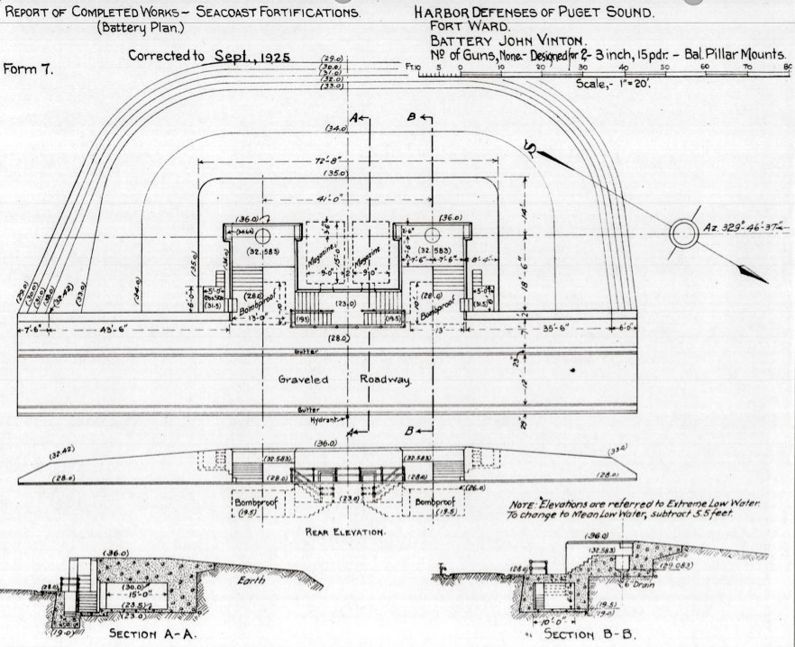Battery Vinton: Difference between revisions
John Stanton (talk | contribs) No edit summary |
John Stanton (talk | contribs) No edit summary |
||
| Line 1: | Line 1: | ||
{{SocialNetworks}} | {{SocialNetworks}} | ||
'''{{PAGENAME}}''' (1904-1920) - Battery John Vinton was a reinforced concrete, [[Endicott Period]] 3 inch coastal gun battery on [[Fort Ward]], Washington. The battery was named in G.O. 194, 27 Dec 1904, after Capt. [[John R. Vinton]], Bvt. Major, [[3rd U.S. Artillery]], who was killed in action at Vera | '''{{PAGENAME}}''' (1904-1920) - Battery John Vinton was a reinforced concrete, [[Endicott Period]], 3 inch coastal gun battery on [[Fort Ward]], Washington. The battery was named in G.O. 194, 27 Dec 1904, after Capt. [[John R. Vinton]], Bvt. Major, [[3rd U.S. Artillery]], who was killed in action at Vera Cruse, Mexico, during the [[Mexican-American War]] Battery construction started in 1903, was completed in 1903 and transferred to the Coastal Artillery for use 18 Jan 1904 at a cost of $ 10,966.50. Deactivated in 1920. | ||
<!-- | <!-- | ||
{{Clr}} | {{Clr}} | ||
Revision as of 19:14, 17 March 2010
Battery Vinton (1904-1920) - Battery John Vinton was a reinforced concrete, Endicott Period, 3 inch coastal gun battery on Fort Ward, Washington. The battery was named in G.O. 194, 27 Dec 1904, after Capt. John R. Vinton, Bvt. Major, 3rd U.S. Artillery, who was killed in action at Vera Cruse, Mexico, during the Mexican-American War Battery construction started in 1903, was completed in 1903 and transferred to the Coastal Artillery for use 18 Jan 1904 at a cost of $ 10,966.50. Deactivated in 1920.
Battery Vinton History
Part of the Harbor Defense of Puget Sound.
Endicott Period
Originally built as an Endicott Period concrete coastal gun battery with two 3" M1898MI rapid fire guns mounted on M1898 balanced pillar mounts.
| Empl No |
Caliber Type |
Barrel Length |
Model | Serial No |
Manufacturer | Carriage | Service Dates |
Notes | |
|---|---|---|---|---|---|---|---|---|---|
| 1 | 3" Rifle | 154.5" | M1898MI | 2 | Driggs-Seabury | Masking Parapet, M1898, #2, Driggs-Seabury |
1904-1920 | See note 1 | |
| 2 | 3" Rifle | 154.5" | M1898MI | 5 | Driggs-Seabury | Masking Parapet, M1898, #5, Driggs-Seabury |
1904-1920 | See note 1 | |
| Source: RCW Form 1,Sep 1925, RCB 31 Dec 1909, CDSG, Berhow, Mark A. ed, American Seacoast Defenses: A Reference Guide, 2nd Edition, CDSG Press, McLean, VA, 2004, ISBN 0-9748167-0-1, pages 70-71, 216 Note 1: Carriages transferred from Driggs-Seabury 11 Jun 1904, guns ordered removed 27 Mar 1920, carriages scrapped 20 May 1920, guns transferred to Watervliet 19 Jul 1920. CDSG Gun Card Collection from NARA | |||||||||

World War I
The U.S. entry into World War I resulted in a widespread removal of large caliber coastal defense gun tubes for service in Europe. Many of the gun and mortar tubes removed were sent to arsenals for modification and mounting on mobile carriages, both wheeled and railroad. Most of the removed gun tubes never made it to Europe and were either remounted or remained at the arsenals until needed elsewhere. The 3" guns of Battery Vinton escaped the World War I redistribution but were removed in the .
Current Status
No period guns or mounts in place. Lower part of the battery is buried.
|
{"selectable":false,"width":"500"} |
Location: Fort Ward, Washington Maps & Images Lat: 47.58134 Long: -122.52568 |
Sources:
Links:
Visited: 20 Jul 2008
Battery Vinton Picture Gallery
|
Click on the picture to see a larger version. Contribute additional pictures - the more the better! |